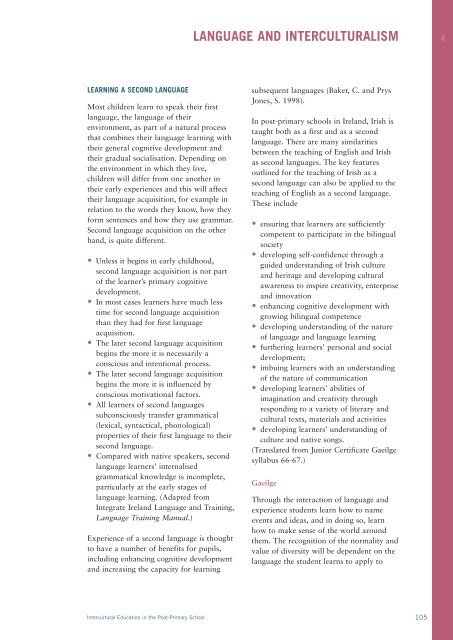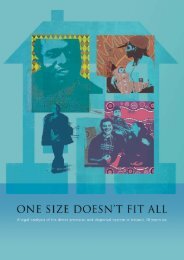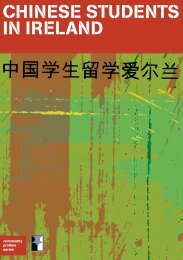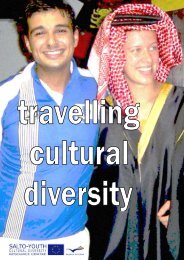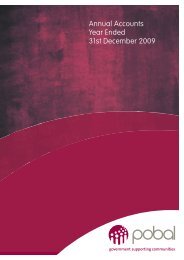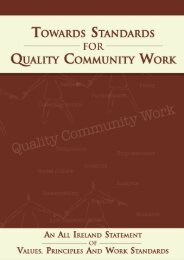Intercultural Education in the Post-Primary School - National Council ...
Intercultural Education in the Post-Primary School - National Council ...
Intercultural Education in the Post-Primary School - National Council ...
You also want an ePaper? Increase the reach of your titles
YUMPU automatically turns print PDFs into web optimized ePapers that Google loves.
LANGUAGE AND INTERCULTURALISM 8LEARNING A SECOND LANGUAGEMost children learn to speak <strong>the</strong>ir firstlanguage, <strong>the</strong> language of <strong>the</strong>irenvironment, as part of a natural processthat comb<strong>in</strong>es <strong>the</strong>ir language learn<strong>in</strong>g with<strong>the</strong>ir general cognitive development and<strong>the</strong>ir gradual socialisation. Depend<strong>in</strong>g on<strong>the</strong> environment <strong>in</strong> which <strong>the</strong>y live,children will differ from one ano<strong>the</strong>r <strong>in</strong><strong>the</strong>ir early experiences and this will affect<strong>the</strong>ir language acquisition, for example <strong>in</strong>relation to <strong>the</strong> words <strong>the</strong>y know, how <strong>the</strong>yform sentences and how <strong>the</strong>y use grammar.Second language acquisition on <strong>the</strong> o<strong>the</strong>rhand, is quite different.• Unless it beg<strong>in</strong>s <strong>in</strong> early childhood,second language acquisition is not partof <strong>the</strong> learner’s primary cognitivedevelopment.• In most cases learners have much lesstime for second language acquisitionthan <strong>the</strong>y had for first languageacquisition.• The later second language acquisitionbeg<strong>in</strong>s <strong>the</strong> more it is necessarily aconscious and <strong>in</strong>tentional process.• The later second language acquisitionbeg<strong>in</strong>s <strong>the</strong> more it is <strong>in</strong>fluenced byconscious motivational factors.• All learners of second languagessubconsciously transfer grammatical(lexical, syntactical, phonological)properties of <strong>the</strong>ir first language to <strong>the</strong>irsecond language.• Compared with native speakers, secondlanguage learners’ <strong>in</strong>ternalisedgrammatical knowledge is <strong>in</strong>complete,particularly at <strong>the</strong> early stages oflanguage learn<strong>in</strong>g. (Adapted fromIntegrate Ireland Language and Tra<strong>in</strong><strong>in</strong>g,Language Tra<strong>in</strong><strong>in</strong>g Manual.)Experience of a second language is thoughtto have a number of benefits for pupils,<strong>in</strong>clud<strong>in</strong>g enhanc<strong>in</strong>g cognitive developmentand <strong>in</strong>creas<strong>in</strong>g <strong>the</strong> capacity for learn<strong>in</strong>gsubsequent languages (Baker, C. and PrysJones, S. 1998).In post-primary schools <strong>in</strong> Ireland, Irish istaught both as a first and as a secondlanguage. There are many similaritiesbetween <strong>the</strong> teach<strong>in</strong>g of English and Irishas second languages. The key featuresoutl<strong>in</strong>ed for <strong>the</strong> teach<strong>in</strong>g of Irish as asecond language can also be applied to <strong>the</strong>teach<strong>in</strong>g of English as a second language.These <strong>in</strong>clude• ensur<strong>in</strong>g that learners are sufficientlycompetent to participate <strong>in</strong> <strong>the</strong> bil<strong>in</strong>gualsociety• develop<strong>in</strong>g self-confidence through aguided understand<strong>in</strong>g of Irish cultureand heritage and develop<strong>in</strong>g culturalawareness to <strong>in</strong>spire creativity, enterpriseand <strong>in</strong>novation• enhanc<strong>in</strong>g cognitive development withgrow<strong>in</strong>g bil<strong>in</strong>gual competence• develop<strong>in</strong>g understand<strong>in</strong>g of <strong>the</strong> natureof language and language learn<strong>in</strong>g• fur<strong>the</strong>r<strong>in</strong>g learners’ personal and socialdevelopment;• imbu<strong>in</strong>g learners with an understand<strong>in</strong>gof <strong>the</strong> nature of communication• develop<strong>in</strong>g learners’ abilities ofimag<strong>in</strong>ation and creativity throughrespond<strong>in</strong>g to a variety of literary andcultural texts, materials and activities• develop<strong>in</strong>g learners’ understand<strong>in</strong>g ofculture and native songs.(Translated from Junior Certificate Gaeilgesyllabus 66-67.)GaeilgeThrough <strong>the</strong> <strong>in</strong>teraction of language andexperience students learn how to nameevents and ideas, and <strong>in</strong> do<strong>in</strong>g so, learnhow to make sense of <strong>the</strong> world around<strong>the</strong>m. The recognition of <strong>the</strong> normality andvalue of diversity will be dependent on <strong>the</strong>language <strong>the</strong> student learns to apply to<strong>Intercultural</strong> <strong>Education</strong> <strong>in</strong> <strong>the</strong> <strong>Post</strong>-<strong>Primary</strong> <strong>School</strong> 105


